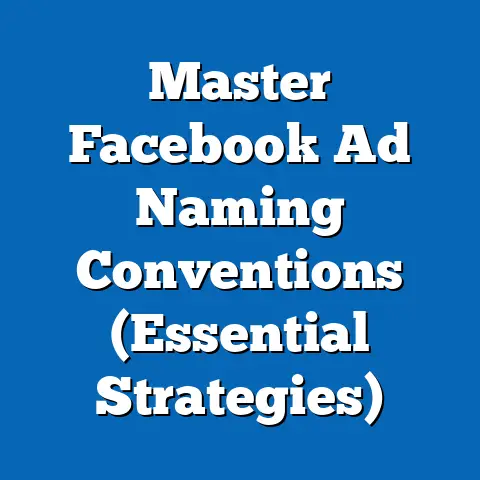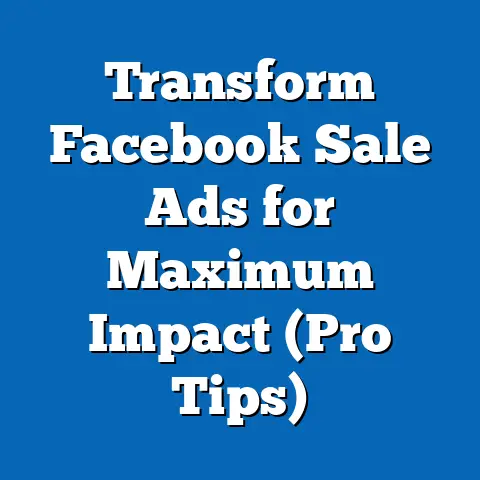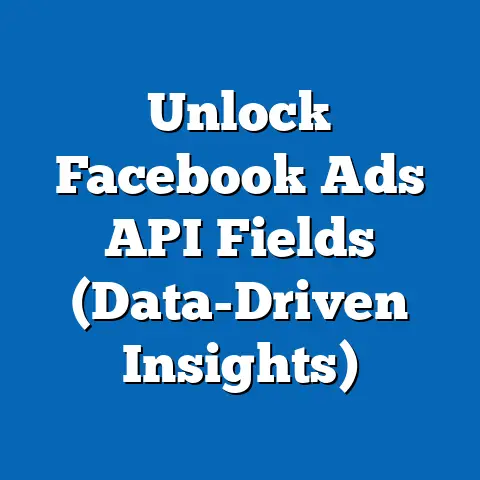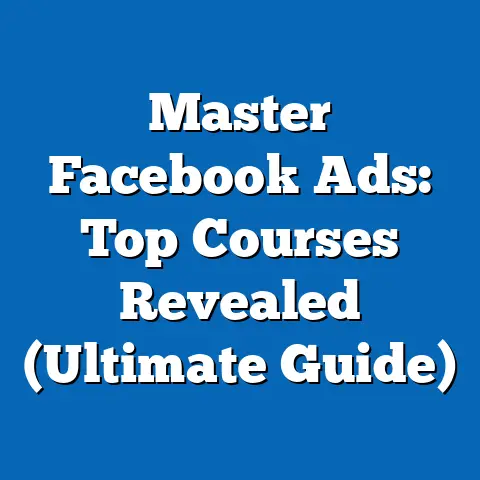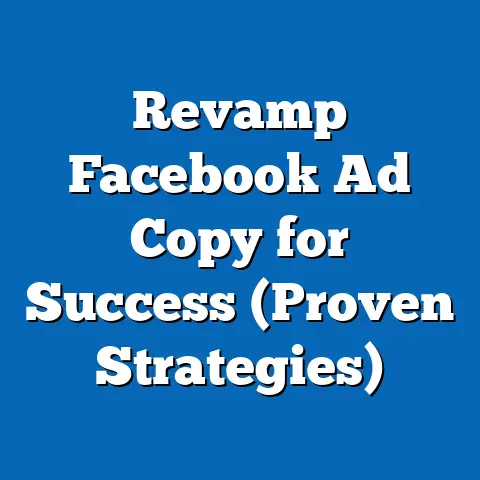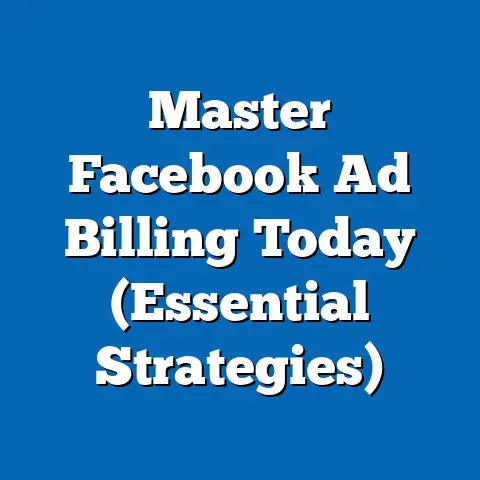Mastering Facebook Ads Text (Pro Tips for Impact)
Imagine this: You’re scrolling through your Facebook feed, a kaleidoscope of colors, memes, and updates flashing before your eyes. Notifications ping, vying for your attention. Your thumb flicks relentlessly, a blur of motion as you skim past countless posts. In this digital whirlwind, how does an advertisement even begin to stand a chance? How can a few lines of text cut through the noise and actually compel someone to stop scrolling and click?
The answer, my friends, lies in mastering the art of Facebook ad text. It’s not just about writing words; it’s about crafting a message so compelling, so relevant, and so perfectly targeted that it resonates with the user on a personal level. It’s about understanding the psychology of the scroll, and knowing how to interrupt it with a compelling hook.
I’ve spent years navigating the ever-evolving landscape of Facebook advertising, seen countless campaigns succeed (and, let’s be honest, fail). Through this journey, I’ve learned that the power of well-crafted ad text is often underestimated. It’s the unsung hero of successful campaigns, the linchpin that connects your product or service with the right audience.
Section 1: Understanding the Facebook Ads Landscape
Before diving into the nitty-gritty of crafting killer ad copy, it’s crucial to understand the environment in which your ads will be living and breathing. Facebook’s advertising ecosystem is a complex beast, and knowing how it works is half the battle.
The Evolution of Facebook Ads:
Facebook advertising has come a long way since its humble beginnings. Remember those early days of simple sidebar ads with generic stock photos? Yeah, me too. It felt like shouting into a void.
Facebook launched its first advertising program in 2004, initially focusing on student profiles. The real turning point came with the introduction of self-serve ads in 2007, allowing businesses of all sizes to create and manage their campaigns. This democratized advertising in a way that hadn’t been seen before.
The platform has undergone a constant evolution, with new ad formats, targeting options, and algorithms constantly being rolled out. From the introduction of mobile ads (a game-changer, considering how much time people spend on their phones) to the sophisticated AI-powered targeting capabilities we have today, Facebook advertising has transformed into a highly sophisticated and effective marketing channel.
Consider these stats:
- Reach: Facebook boasts nearly 3 billion monthly active users worldwide. That’s a massive audience you can potentially tap into.
- Ad Revenue: Facebook’s ad revenue continues to climb, reaching billions of dollars per quarter. This demonstrates the platform’s effectiveness and the confidence advertisers have in it.
- ROI: Studies consistently show that Facebook ads can deliver a strong return on investment, especially when campaigns are well-targeted and optimized.
The key takeaway here is that Facebook advertising is a powerful tool, but it requires understanding, strategy, and constant adaptation to stay ahead of the curve.
Target Audience Insights:
Knowing your audience is not just important; it’s everything. You can have the most brilliantly written ad copy in the world, but if it’s shown to the wrong people, it’s going to fall flat. It’s like trying to sell snow to Eskimos – a waste of time and resources.
Facebook’s targeting capabilities are incredibly granular. You can target users based on:
- Demographics: Age, gender, location, education, relationship status, job title, and more.
- Interests: Hobbies, passions, activities, pages they’ve liked, and topics they engage with.
- Behaviors: Purchase history, online activity, device usage, and travel patterns.
- Custom Audiences: Upload your own customer lists (email addresses, phone numbers) to target existing customers or create lookalike audiences.
- Lookalike Audiences: Find new people who share similar characteristics with your existing customers. This is a goldmine for expanding your reach.
I remember working on a campaign for a local bakery that specialized in gluten-free products. Instead of just targeting “foodies” in the area, we drilled down to target people with specific dietary restrictions (e.g., “celiac disease,” “gluten intolerance”) and those who had shown interest in gluten-free recipes and blogs. The results were astounding. We saw a significant increase in website traffic and in-store visits, proving the power of laser-focused targeting.
The moral of the story? Don’t guess. Use Facebook’s targeting options to identify your ideal customer and tailor your ad copy to resonate with their specific needs and desires.
The Role of Ad Text in User Engagement:
In the fast-paced world of social media, your ad text has a split second to grab attention and make an impact. It’s the first (and often only) chance you get to connect with potential customers.
Think of your ad text as a mini-sales pitch. It needs to be:
- Relevant: Address the user’s specific needs or interests.
- Engaging: Capture their attention and spark their curiosity.
- Persuasive: Convince them to take action (e.g., click on your ad, visit your website, make a purchase).
Let’s look at some examples:
Ineffective Ad Text:
- “We sell widgets! Buy now!” (Generic, boring, and doesn’t tell the user why they should care.)
Effective Ad Text:
- “Tired of tangled headphones? Our wireless earbuds deliver crystal-clear sound and a comfortable fit. Get yours today and experience the freedom of wireless audio!” (Addresses a specific pain point, highlights key benefits, and includes a clear call to action.)
The difference is clear. The effective ad text speaks directly to the user’s needs and desires, while the ineffective ad text is simply a generic sales pitch.
Key Takeaway: Understanding the Facebook ads landscape, knowing your audience, and crafting compelling ad text are the foundational elements of successful campaigns. Don’t skip these steps!
Next Steps:
- Research your target audience using Facebook Audience Insights.
- Analyze successful ads in your industry to identify what resonates with your target audience.
- Brainstorm different approaches to crafting compelling ad copy that addresses your audience’s needs and desires.
Section 2: Crafting Compelling Ad Copy
Now that you have a solid understanding of the Facebook advertising ecosystem, let’s dive into the art of crafting compelling ad copy that grabs attention and drives results.
The Anatomy of Powerful Ad Text:
Facebook ad text typically consists of three main components:
- Headline: The headline is the first thing users see, so it needs to be attention-grabbing and concise. It should clearly communicate the main benefit or value proposition of your product or service.
- Body Text: The body text provides more detail about your product or service and explains why the user should take action. It should be engaging, persuasive, and relevant to the user’s needs and interests.
- Call to Action (CTA): The CTA tells the user what you want them to do next (e.g., “Learn More,” “Shop Now,” “Sign Up”). It should be clear, concise, and action-oriented.
Let’s break down a successful ad example:
Headline: “Finally! A CRM That Doesn’t Suck”
Body Text: “Tired of clunky, outdated CRM software? Our intuitive platform makes it easy to manage your leads, track your sales, and close more deals. Try it free for 14 days!”
CTA: “Start Free Trial”
Why does this ad work?
- Headline: It’s attention-grabbing and provocative. It speaks directly to the frustration many people feel with traditional CRM systems.
- Body Text: It highlights the key benefits of the CRM (intuitive platform, easy to manage leads, track sales, close more deals) and offers a risk-free trial.
- CTA: It’s clear and action-oriented. It tells the user exactly what to do next.
Pro Tip: Use numbers and statistics in your headlines and body text to add credibility and make your ad more attention-grabbing. For example, “Increase your sales by 30% with our CRM software!”
Using Emotional Triggers:
Emotions are powerful drivers of human behavior. Tapping into emotions in your ad copy can create a strong connection with your audience and increase the likelihood that they’ll take action.
Here are some common emotional triggers you can use in your ad copy:
- Joy: Highlight the positive emotions associated with your product or service (e.g., happiness, excitement, satisfaction).
- Fear: Address the user’s fears or anxieties and offer a solution (e.g., fear of missing out, fear of losing money, fear of getting sick).
- Urgency: Create a sense of urgency to encourage immediate action (e.g., limited-time offer, sale ending soon, only a few spots left).
- Curiosity: Spark the user’s curiosity and make them want to learn more (e.g., “The secret to…” “You won’t believe…” “Discover the hidden truth about…”).
- Belonging: Make the user feel like they’re part of a community or tribe (e.g., “Join thousands of satisfied customers…” “Become a member of our exclusive club…”).
I once ran a campaign for a travel agency that specialized in adventure tours. Instead of just focusing on the destinations, we highlighted the emotions associated with adventure travel: excitement, freedom, exhilaration, and a sense of accomplishment. The ad copy read: “Escape the ordinary and embark on an unforgettable adventure! Discover the thrill of conquering a mountain, exploring a hidden jungle, or diving into the depths of the ocean.” The response was overwhelming. People were drawn to the emotional connection we created with them.
Key Takeaway: Don’t be afraid to tap into emotions in your ad copy. It can be a powerful way to connect with your audience and drive results.
Clarity and Conciseness:
In the world of Facebook advertising, less is often more. Users are bombarded with information, so you need to get your message across quickly and effectively.
Here are some tips for writing clear and concise ad copy:
- Use short, simple sentences.
- Avoid jargon and technical terms.
- Focus on the key benefits of your product or service.
- Get straight to the point.
- Use strong verbs and active voice.
- Proofread your ad copy carefully to catch any errors.
I’ve seen countless ads fail simply because they were too complicated or confusing. People don’t have the time or patience to decipher a convoluted message. They want to know what you’re offering and why they should care, plain and simple.
Pro Tip: Read your ad copy aloud to see how it sounds. If it sounds clunky or awkward, it’s probably not clear enough.
Key Takeaway: Clarity and conciseness are essential for effective ad copy. Get your message across quickly and easily, and you’ll be more likely to capture the user’s attention and drive results.
Next Steps:
- Brainstorm different headlines, body text, and CTAs for your ads.
- Experiment with different emotional triggers to see what resonates with your audience.
- Practice writing clear and concise ad copy that gets straight to the point.
Section 3: Advanced Techniques for Facebook Ad Text
Once you’ve mastered the basics of crafting compelling ad copy, it’s time to take your skills to the next level with some advanced techniques.
A/B Testing Your Ad Copy:
A/B testing, also known as split testing, is the process of comparing two or more versions of your ad copy to see which one performs better. It’s a crucial step in optimizing your campaigns and maximizing your ROI.
Here’s how A/B testing works:
- Create two or more versions of your ad copy. Change only one element at a time (e.g., headline, body text, CTA) to isolate the impact of that specific change.
- Run your ads simultaneously. Make sure the ads are shown to the same audience and for the same duration.
- Track your results. Monitor key metrics such as click-through rate (CTR), conversion rate, and cost per acquisition (CPA).
- Analyze your data. Identify which version of your ad copy performed better and use that information to inform your future campaigns.
I remember working on a campaign for an e-commerce store that sold handmade jewelry. We were struggling to get a decent CTR on our ads. We decided to A/B test two different headlines:
- Headline A: “Beautiful Handmade Jewelry”
- Headline B: “Unique Handmade Jewelry You Won’t Find Anywhere Else”
After running the ads for a week, we discovered that Headline B significantly outperformed Headline A. The CTR was nearly double, and the conversion rate was also higher. The reason? Headline B emphasized the uniqueness and exclusivity of the jewelry, which resonated more with our target audience.
Key Takeaway: A/B testing is essential for optimizing your ad copy and maximizing your ROI. Don’t be afraid to experiment with different variations to see what works best.
Incorporating Keywords and SEO Strategies:
While Facebook isn’t a search engine in the traditional sense, keywords still play an important role in ad relevance and visibility. Incorporating relevant keywords into your ad copy can help you reach a more targeted audience and improve your ad’s Quality Score, which can lower your costs and improve your ad’s performance.
Here are some tips for incorporating keywords into your ad copy:
Key Takeaway: Incorporating relevant keywords into your ad copy can help you reach a more targeted audience and improve your ad’s performance.
Leveraging User-Generated Content:
User-generated content (UGC) is any content created by your customers or fans, such as testimonials, reviews, photos, and videos. Incorporating UGC into your ad copy can be a powerful way to build trust and credibility and increase your conversion rate.
Here’s how to leverage UGC in your ad copy:
- Include testimonials and reviews. Use positive testimonials and reviews from satisfied customers to showcase the value of your product or service.
- Feature customer photos and videos. Ask your customers to share photos and videos of themselves using your product or service.
- Run contests and giveaways. Encourage your customers to create content related to your brand and reward them for their efforts.
I worked on a campaign for a skincare company that used UGC extensively. We featured customer testimonials and before-and-after photos in our ads, and the results were amazing. People were much more likely to trust the claims made by real customers than the claims made by the company itself.
Key Takeaway: Leveraging UGC in your ad copy can be a powerful way to build trust and credibility and increase your conversion rate.
Next Steps:
- Start A/B testing your ad copy to identify what works best.
- Research relevant keywords and incorporate them into your ad copy.
- Find ways to leverage UGC in your ad copy to build trust and credibility.
Section 4: The Importance of Compliance and Best Practices
Creating effective ad copy is only half the battle. You also need to make sure your ads comply with Facebook’s advertising policies and adhere to best practices.
Facebook’s Advertising Policies:
Facebook has a strict set of advertising policies that you need to follow. Violating these policies can result in your ads being disapproved, your account being suspended, or even your account being permanently banned.
Some of the most important policies to be aware of include:
- Prohibited Content: You can’t advertise illegal products or services, discriminatory content, or misleading or deceptive content.
- Personal Attributes: You can’t target users based on personal attributes such as race, ethnicity, religion, sexual orientation, or health status.
- Health and Medical Content: You need to be careful when advertising health and medical products or services. You can’t make false or misleading claims, and you need to comply with all applicable laws and regulations.
- Grammar and Punctuation: Your ad copy needs to be grammatically correct and free of spelling errors.
- Sensational Content: Avoid using sensational or shocking content that is likely to offend or upset users.
I’ve seen many advertisers get their accounts suspended for violating Facebook’s advertising policies. It’s important to read the policies carefully and make sure your ads comply with all the rules. It’s not worth risking your account for a few extra clicks.
Key Takeaway: Familiarize yourself with Facebook’s advertising policies and make sure your ads comply with all the rules.
Cultural Sensitivity and Inclusivity:
In today’s world, it’s more important than ever to be culturally sensitive and inclusive in your advertising. Your ad copy should resonate with diverse audiences and avoid making assumptions or stereotypes.
Here are some tips for creating culturally sensitive and inclusive ad copy:
- Use inclusive language. Avoid using gendered language or language that excludes certain groups of people.
- Represent diversity in your visuals. Make sure your ad images and videos feature people from diverse backgrounds.
- Be aware of cultural nuances. What works in one culture may not work in another. Do your research and make sure your ad copy is appropriate for the target audience.
- Avoid stereotypes. Don’t rely on stereotypes in your ad copy. They can be offensive and inaccurate.
I once worked on a campaign for a global brand that made the mistake of using a stereotype in their ad copy. The ad was quickly pulled after receiving a barrage of complaints. It’s important to be mindful of cultural sensitivities and avoid making assumptions about your target audience.
Key Takeaway: Be culturally sensitive and inclusive in your advertising. Your ad copy should resonate with diverse audiences and avoid making assumptions or stereotypes.
Next Steps:
- Review Facebook’s advertising policies and make sure your ads comply with all the rules.
- Be mindful of cultural sensitivities and inclusivity when creating your ad copy.
- Get feedback from diverse audiences to make sure your ads resonate with them.
Section 5: Measuring Success and Continuous Improvement
Creating effective ad copy is an ongoing process. You need to constantly measure your results, analyze your data, and refine your approach to maximize your ROI.
Key Performance Indicators (KPIs):
Key Performance Indicators (KPIs) are metrics that you use to track the performance of your ads. Some of the most important KPIs for measuring the success of Facebook ad text include:
- Click-Through Rate (CTR): The percentage of people who see your ad and click on it. A high CTR indicates that your ad copy is relevant and engaging.
- Conversion Rate: The percentage of people who click on your ad and take the desired action (e.g., make a purchase, sign up for a newsletter, download a white paper). A high conversion rate indicates that your ad copy is persuasive and effective.
- Cost Per Acquisition (CPA): The cost of acquiring a new customer through your advertising. A low CPA indicates that your ads are efficient and cost-effective.
- Return on Ad Spend (ROAS): The amount of revenue you generate for every dollar you spend on advertising. A high ROAS indicates that your ads are profitable.
I always tell my clients to focus on the KPIs that are most relevant to their business goals. If your goal is to generate leads, focus on conversion rate and CPA. If your goal is to increase brand awareness, focus on reach and engagement.
Key Takeaway: Track your KPIs regularly and use that data to inform your advertising strategy.
Staying Updated with Trends:
The world of Facebook advertising is constantly evolving. New ad formats, targeting options, and algorithms are being rolled out all the time. It’s important to stay updated with the latest trends and best practices to stay ahead of the curve.
Here are some ways to stay updated with trends in Facebook advertising:
- Read industry blogs and publications.
- Attend industry conferences and webinars.
- Follow industry experts on social media.
- Experiment with new ad formats and targeting options.
- Join online communities and forums.
I make it a point to spend at least an hour each week reading industry blogs and publications. It’s the best way to stay informed about the latest trends and best practices.
Key Takeaway: Stay updated with trends in Facebook advertising to stay ahead of the curve and maximize your ROI.
Next Steps:
- Track your KPIs regularly and analyze your data to identify areas for improvement.
- Stay updated with trends in Facebook advertising to stay ahead of the curve.
- Continuously experiment with new ad formats, targeting options, and ad copy to optimize your campaigns.
Conclusion:
Mastering Facebook ads text is an ongoing journey, a constant process of learning, experimenting, and refining. It’s not a one-size-fits-all solution. What works for one business may not work for another. The key is to be adaptable, creative, and data-driven.
Remember, your ad text is the voice of your brand. It’s the first impression you make on potential customers. Make it count. Craft compelling ad copy that resonates with your target audience, builds trust, and drives results.
As the great copywriter David Ogilvy once said, “On the average, five times as many people read the headline as read the body copy. When you have written your headline, you have spent eighty cents out of your dollar.”
Take the tips and strategies I’ve shared in this guide and apply them to your own campaigns. Experiment with different approaches, track your results, and continuously refine your ad copy to maximize your ROI.
The potential impact of well-crafted ad text on your advertising success is enormous. Don’t underestimate its power. Embrace the challenge, hone your skills, and watch your campaigns soar. Now go forth and conquer the Facebook feed!

